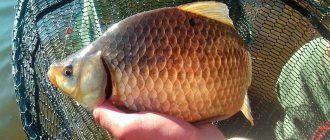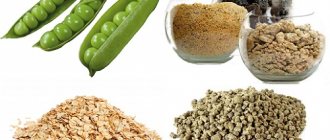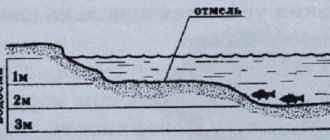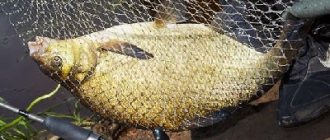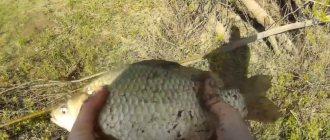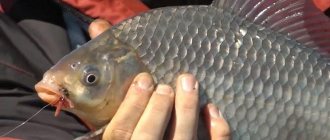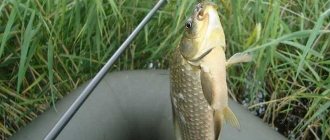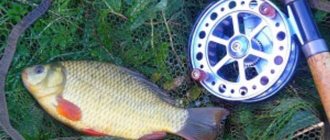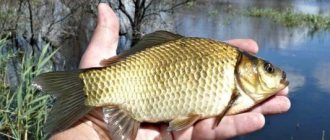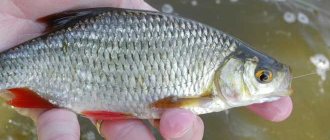With the arrival of the spring thaw, the first fishermen begin to go to the reservoirs in order to hunt for the mischievous crucian carp. Now it is necessary to look for it in muddy shallow waters located not far from the shore, where it basks and feeds in water warmed by the spring rays. At the same time, many floaters unfairly believe that catching crucian carp on a feeder in the spring is unpromising. Moreover, only they think so, and we, lovers of feeder fishing, know what gear should be used in order to ensure a stable bite for the lively handsome fish.
Where to look for crucian carp in spring
collect feeder gear for catching crucian carp as soon as the reservoir opens up from the ice crust, only now it is still sluggish and inactive.
The fisherman needs to be prepared that in early spring the mood of crucian carp is quite changeable; even minor changes in temperature, pressure, wind or precipitation can affect the bite. In addition, not all reservoirs begin to catch it immediately; sometimes you have to wait until the end of March, and in some regions, mid-April, until the water warms up to 6-7 degrees.
Much depends on the reservoir itself, its depth and the presence of extensive shallow waters, which is why in early spring to catch crucian carp, search tactics may be used rather than sedentary fishing in one place.
Crucian carp are very attached to their habitats, and if you know several places where they bit well last spring, start your fishing there.
Crucian carp is a heat-loving fish and the higher the water temperature, the more active it behaves. The best time for catching crucian carp on a feeder in the spring is considered to be the period when the weather outside is warm and clear (at least 11-13 degrees) for several days.
In spring, crucian carp must be looked for in the coastal zone, where it chooses quiet, shallow muddy areas up to 1.5 m deep.
And first of all, it’s worth catching:
- Areas near snags and bushes and trees fallen into the water;
- Places at the edge of aquatic vegetation (algae, reeds, especially if young shoots have appeared);
- Areas where tree crowns hang over the water;
- Meadows flooded by floods;
An exception may be large crucian carp that do not want to come close to the shore.
Fishing for crucian carp with a feeder in the spring is more successful in stagnant bodies of water (stakes, ponds, lakes), here the water warms up an order of magnitude faster. But on rivers you can’t catch crucian carp everywhere; first of all, you need to look for it in creeks, bays and oxbow lakes, where the current is either absent or weak and the water warms up better.
In spring, crucian carp are very cautious and timid, so any noise on the shore can scare them away. Therefore, many fishermen throw feeders into shallow water located on the opposite bank.
When the water warms up to 18 degrees (for many regions this is May), the crucian carp begins to spawn, during this period its biting subsides, but several weeks before and after spawning, the crucian carp actively feeds, so you need to catch this moment.
You can catch crucian carp in the spring throughout the day; the most active bite is from dawn to noon; at lunchtime it can subside and resume in the late afternoon.
Tactics
Catching crucian carp on a feeder is quite simple and does not require any great knowledge of handling tackle and equipment. The only thing you need to know is how to make the right tackle, proper feeding tactics and choosing a location. Let's take a closer look at the main stages of feeder fishing for crucian carp.
Pre-cast
The main requirement when using feeder gear is to minimize the percentage of misses, that is, try to throw the equipment at one point as often as possible. To make this difficult task easier for themselves, fishermen often make preliminary casts without equipment (just a weight on the main line). It's very easy to do this:
- First you need to choose a landmark on the opposite bank
, it could be a tree, a large house or any other noticeable object that does not change its position. - Now throw the tackle to the intended fishing spot and fix the line on the reel
using a special clip (this action will allow you to control the casting distance).
Lure
A very important stage is the preliminary feeding of the fishing spot, which is done using a specially prepared bait feeder. Before you start fishing, you need to make 6-7 casts with this gear.
But even here, not everything is simple. To create a cloudy cloud of bait, you need to pour the mixture out of the feeder the moment it touches the water. This is done with 2-3 feeders, the rest of the bait is released from the feeder already at the bottom.
Spring tackle for crucian carp
Rod
A medium-class feeder blank with a test weight of up to 90 g, a medium or fast action, and having a length of 3.6-3.9 m will be universal. With this rod you can fish both at short distances and cast to the opposite bank of the reservoir.
When your fishing distance does not exceed 20-25 m, a picker rod with a weight of up to 40 grams would be an excellent option; the feeder is light and makes an order of magnitude less noise when casting. The length of such rods does not exceed 3 meters, which is very convenient when you fish on a bank overgrown with dense vegetation or under the canopy of trees.
Coil
To catch crucian carp on a feeder in the spring, a small inertia-free reel with a spool size of 2500-3000 is sufficient, the main thing is that it is balanced with the rod. Do not forget about the presence of a good clutch, since in the spring in shallow water you can find not only crucian carp, but also more respectable fish.
fishing line
Monofilament with a diameter of 0.2-0.24 mm or braided 0.12-0.15 mm, braided fishing line works especially well in early spring, when the fish are inactive and take the bait very carefully. Leaders are 0.03 mm thinner than the main line or designed for a lower breaking load.
When equipping a reel with braided fishing line, do not forget that the spool must be metal or coated, and the guide rings must be equipped with special inserts.
When fishing in shallow water during strong winds, your line may begin to blow out of the quivertip, making it impossible for you to track bites. You can solve this problem by using a shock leader made of fluorocab in two rod lengths; it will sink your line well.
Feeders
On moderately silted bottoms, regular cage feeders can be used. On reservoirs with a large layer of silt, fishing for crucian carp on a feeder in the spring is preferable to plastic feeders with plastic wings on the sides and flat-method feeders.
Hooks
Sharp, but not too thin, since crucian carp have delicate lips, size No. 16-18 according to the international classification.
What is feeder gear?
Feeder gear for catching crucian carp is a spinning rod with a spinning reel equipped with a 0.28 mm thick fishing line or a 0.14 mm cord that can withstand a decent load. A feeder is a feeder into which bait is placed. If you are fishing on a river, the weight of the feeder is determined depending on the strength of its current. As a rule, the feeder weighs 50-60 grams. and together with the anti-twist it is put on the main fishing line. At the end of the fishing line, a swivel is attached with one or two leashes of varying lengths. The thickness of the fishing line for leashes is 0.2 mm, hooks will fit No. 5. This size will be enough to prevent large crucian carp from jumping off.
Video: catching crucian carp in the spring on a feeder
Equipment for catching crucian carp on a feeder in spring
The best spring equipment is:
- Paternoster;
- Inline method;
- Running Feeder (inline);
Paternoster loop installation:
- Take a piece of fishing line 1.2 m long
- We make a branch loop, for which we will subsequently attach the feeder. To do this, we retreat 50 cm from the edge of the fishing line. In the place of the indentation, we fold the fishing line in half, so that we form a loop 10 cm long. We fix the resulting loop using a figure eight knot. We attach the feeder to the loop using an American fastener.
- We hang the resulting tackle in our hand, holding the long edge of the fishing line. We bring the end of the fishing line, from which we retreated, to the feeder and make a small surgical loop on it, but so that in a suspended state it is 5 cm below the edge of the feeder.
- The leash is attached to this loop using the loop-to-loop method. The length of the leash depends on the intensity of the bite; if the bite is weak and cautious, then it is better to install leashes 1 m long; with active biting, their length can be reduced to 30 cm.
- At the remaining free end of the fishing line we knit a surgical loop, departing 40-50 cm from the beginning of the loop with the feeder. The main fishing line will be attached to this loop.
Equipment inline installation method:
Fishing for cautious crucian carp on a feeder in the spring is quite successful using the sliding version of the rig method. It is knitted quite simply:
We take a piece of fishing line 45 cm long. We knit a swivel at one end, a leash 7-10 cm long will be attached to it. Next, we pass a bead through the free end, which will prevent the feeder from hitting the knot, damaging it, and will not allow the swivel to get stuck inside it. Now we pass the feeder, and behind it again the bead. A surgical loop is knitted at the edge of the rig, and the main fishing line is attached to it. Instead of a loop, you can also use a swivel.
The Running Feeder rig is especially effective for cautious fish, since when biting the feeder slides along the main line and the fish does not feel the weight of the sinker. Read about the rules for installing Running Feeder here.
"Pacifier"
This is the name of an undeservedly forgotten tackle that can be used in feeder fishing, including crucian carp. It is distinguished from other gear by its simplicity, compactness and catchability.
The simplicity lies in the fact that it can simply be assembled from auxiliary materials. The basis of its design is a plastic cap from a plastic bottle, a small piece of wire with a diameter of 0.6 mm and a leash with a hook 5-7 cm long. Compactness is inherent in the design itself: a round weight is screwed directly to the lid from below. When casting, the leashes never overlap, since they are hidden in the bait, and only after the tackle gets into the water, when the bait begins to gradually wash out, are the hooks with bait released.
This gear is no different in its catchability from other gear. A small amount of bait is placed in the lid, and therefore the fish is not overfed, and with each cast it whets its appetite more and more.
Catching crucian carp on a feeder in spring, choosing bait
The spring diet of crucian carp is replete with protein foods and is now its priority:
- Oparish;
- Bloodworm;
- Dung worms;
- Crawls;
- Grasshoppers;
- Caterpillars;
- Larvae of various insects (mayflies, bark beetles, dragonflies, May beetles);
In order to increase the attractiveness of your bait, you can simultaneously attach several different baits to the hook, for example: a worm and maggot, a bunch of bloodworms and pieces of a worm. Also quite interesting would be a mix of animal and vegetable toppings (bread, dough, corn).
There are reservoirs where crucian carp, even in March, bite well on chatterbox, steamed pearl barley and semolina.
Nevertheless, crucian carp steadily begins to peck on plant baits towards the end of spring.
Vegetable baits for crucian carp:
- Bread crumb, dough, small boilies;
- Steamed or boiled grains (wheat, millet, barley, corn, peas. Trophy crucian carp can often be caught on canned peas and corn;
- Boiled porridges (Semolina, Hercules, hominy).
- Catching crucian carp on a feeder in the spring requires experimenting with baits, so you should take at least 3-4 varieties of animal and plant baits with you.
Fishing technique
An important condition for successful fishing is determining the fishing location. You should start fishing the territory of the reservoir from the coastal areas, constantly moving further and further from the shore in search of crucian carp. You should not immediately make long casts - sometimes you can catch more fish closer to the shore than in the middle of the pond. When catching crucian carp, small hooks are mainly used, using mastyrka as bait. A large hook scares away crucian carp, especially if a maggot or worm is used. Crucian carp likes to suck the bait before biting and, in the end, refuses it, and it instantly sucks up a small hook with a drop of mastyrka.
You can successfully catch crucian carp at night - at this time it comes to the shore, to the edges, where it feeds. This does not require long casting and a heavy feeder: you can use a lighter feeder. A lightweight and reliable rod will allow you to cast the tackle silently. In this case, the bait can be thrown in manually (not far from the shore). The bait may contain vegetable components with the addition of maggots and must be loose. Once in the water, such bait immediately begins to disintegrate, creating a feeding spot that will actively attract crucian carp. You should be careful with lighting at night, as it can scare away crucian carp, and put the bait on the hook, preferably at some distance from the shore.
Spring bait for crucian carp
The choice of spring bait for crucian carp directly depends on the temperature, just like when choosing any other bait for feeder fishing in the spring . So in cold water (up to 15 0C), the bait should not have many nutrients, otherwise you will overfeed the fish, and the crucian carp will not want to attack your bait.
The easiest way to get spring bait is to buy it in a store; you need to buy a mixture designed for fishing in cold water. Summer bait options should be purchased for warm water (closer to the end of spring).
Store-bought bait is simple and quick, but homemade bait is a field for experiments and possibilities. The following ingredients are used as a base:
- Cake;
- Millet
- Ground oats;
- Bran;
- Breadcrumbs;
Also, protein ingredients must be added to the bait, primarily those with which you are going to fish:
- Chopped worm;
- Maggot;
- Bloodworm;
If you hunt in an area of a reservoir that is closely adjacent to a pasture, then you can add grasshoppers, flies or other insects that live near it and are natural food for crucian carp to the bait.
In order to give the effect of the presence of “a large amount of yummy”, the bait is mixed with soil, which it is advisable to dig up on the shore of the reservoir where you are going to fish, in this case the bait at the bottom will look more natural.
For stagnant bodies of water, this is land. It is mixed with bait in proportions of one to one. During the current you will need clay, the amount of clay depends on the strength of the current. If you add too little, the bait will quickly wash out of the feeder; if you add too much, it will turn into a hard lump. As a rule, the bait should be washed out of the feeder within 10 minutes.
The starting feeding consists of 5-6 feeders; if the fish does not respond to the bait, then remove the feeder and put a lead sinker, fishing as with a regular bottom. The fact is that crucian carp is very timid in the spring and can be confused by the unnatural impacts of the feeder on the water. The main thing is that we have created a feeding spot on the bottom, and now we rarely have to re-cast and wait for a bite. Working with the length and thickness of the leash, the size of the hook and the type of bait.
To successfully catch crucian carp on a feeder in the spring, we will need flavoring agents. Only in the spring, especially early, you need to be very careful with them; due to incorrectly selected or added too much aroma, you can easily be left without fish.
Experienced fishermen first test the mood of the fish without adding flavorings to the bait, and if the bite is weak and unstable, they try to experiment.
In spring, crucian carp prefer natural aromas:
- Ground dill and caraway seeds;
- Garlic;
- Calamus root;
- Cocoa;
- Burdock and cattail rhizomes;
Closer to May, when the water temperature rises significantly, you can add flavorings to the bait:
- Banana;
- Tutti Frutti;
- Strawberries;
- Peach
- Crucian carp loves the sweetish taste of bait, so sugar, honey and vanilla are often added to it.
Homemade bait recipes:
Recipe No. 1
The simplest recipe is to mix maggots, bloodworms or worms with soil in a ratio of 10:1. That is, for 400 grams of worms, we need 4 kg of soil. At the same time, despite the simplicity of the mixture, catching crucian carp on a feeder in the spring will be no less effective.
Recipe No. 2
- Finely ground roasted sunflower seeds – 500 grams;
- Wheat bran – 500 grams;
- Ground crackers 400-500 grams;
- Vanilla sugar - 40-45 crystals;
- Sugar – 10 grams;
Recipe No. 3
- Chopped worms 200-300 grams;
- Wheat bran - 1000 grams;
- Oatmeal (Hercules) – 500 grams;
- Makukha - 500 grams;
- Breadcrumbs 500 grams;
- Powdered milk – 100 grams
Fishing for crucian carp
For successful fishing, it is recommended to make several test casts of empty gear to the intended location. This will help to most accurately deliver the feeder to the planned area. After the tackle hits, a mark is made on the fishing line, which fixes its length for subsequent casts. Next, the area is fed. After half an hour, you can start fishing for crucian carp.
Having detected a bite, the fish needs to be hooked. When fishing, crucian carp can show aggression, and in order to prevent it from breaking, it is also recommended to show aggression by pulling and reeling in the fishing line. Crucian carp fights for its life to the last, so when you see it on the surface, you shouldn’t relax. To avoid missing fish at the last moment, it is recommended to use a landing net.
Crucian carp is an unpredictable fish that requires constant experimentation, however, one rule always applies.
By positioning the tip of the feeder rod as close to the surface of the water as possible, the angler is more likely to spot a clean bite. In this case, it is better to hook the fish to the side with a very smooth movement. By following this rule, you can feel a significant reduction in water resistance. Article on the topic: What should a float for crucian carp be like?


